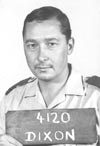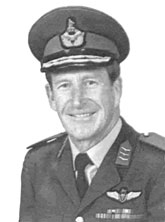The Commendation Medal is a mid-level United States military decoration presented for sustained acts of heroism or meritorious service. Each branch of the United States Armed Forces issues its own version of the Commendation Medal, with a fifth version existing for acts of joint military service performed under the Department of Defense.

Squadron Leader Christopher John Taylor Dixon D.C.D., also known by his callsign of Green Leader, was a Rhodesian military pilot for the Rhodesian Air Force and was born in Shabani, Southern Rhodesia. He was best known for leading the Rhodesian Operation Gatling bombing raid over Zambia, which later became known as the "Green Leader Raid".
The Rhodesian honours system was established at the time that Rhodesia unilaterally declared itself a republic in March 1970, when a system of military and civil decorations and awards was instituted by Presidential Warrant in November 1970.
The Legion of Merit was a Rhodesian order of merit awarded to both civilian and military recipients for service to Rhodesia.

The Silver Cross of Rhodesia was Rhodesia's second-highest military decoration for conspicuous gallantry.

The Zimbabwean Independence Medal, 1980 was instituted on 17 April 1980 for award to those who were involved in the Zimbabwean independence process or commemorations in some way.

The Grand Cross of Valour was Rhodesia's highest military decoration, awarded for conspicuous valour by members of the Security Forces in combat.
The Conspicuous Gallantry Decoration was Rhodesia's highest civil decoration and the second-highest award available to members of the armed forces. It was awarded for acts of the highest gallantry and brave conduct of an outstanding order in a non-combatant capacity.

The Rhodesia General Service Medal was the most widely awarded military medal of Rhodesia. It was awarded to members of the security forces and British South Africa Police for service on operations undertaken for the purpose of combatting terrorists or enemy incursions into Rhodesia.
The Independence Decoration was a Rhodesian civil decoration awarded to persons who played a notable and significant part in the Unilateral Declaration of Independence in 1965.
The Police Decoration for Gallantry was a Rhodesian gallantry award. It was awarded for gallantry to members of the British South Africa Police, Police Support Unit, and Police Reserve.
The Police Decoration for Gallantry was a Rhodesian gallantry award. A handful were awarded for conspicuous gallantry to members of the British South Africa Police, Police Support Unit and Police Reserve.
The Independence Commemorative Decoration was a Rhodesian civil decoration awarded to persons who had rendered valuable service to Rhodesia. The award was instituted in 1970 by Presidential Warrant, the first awards being made the same year. Recipients were entitled to the post-nominal letters ICD.
The Defence Cross for Distinguished Service was a Rhodesian military decoration awarded for distinguished service to Rhodesia's armed forces.

Air Marshal Norman Walsh was a senior officer in the Rhodesian Air Force and the first commander of the Air Force of Zimbabwe.

The Rhodesia Medal was initiated by the British Government in consultation with Australia, New Zealand, Fiji and Kenya, whose forces took part in Operation AGILA. The role of the multi-national force was to keep peace between 22,000 guerrilla fighters and the Rhodesian forces during the ceasefire and run-up to the 1980 elections.
Air Marshal Archibald Oliver Garfield Wilson was a Rhodesian fighter pilot who served in the Royal Air Force during World War II. He went on to become a senior commander and then Air Marshal in the Rhodesian Air Force in the 1960s and early 1970s. After retirement, he served two terms in the Rhodesian House of Assembly, in the Zimbabwe-Rhodesian Parliament in 1979, and then in the Zimbabwe Parliament in 1981–1982. He held several cabinet portfolios prior to the Internal Settlement. He resigned in 1982 to emigrate, with his wife Lorna, to Australia's Gold Coast in 1982. He became a citizen of Australia in 1988.

Major Arthur Walker HCG and Bar, SM was a South African Air Force helicopter pilot who was twice awarded the Honoris Crux Gold decoration during the South African Border War. The Honoris Crux Gold was the highest military award for bravery awarded to members of the South African Defence Force.
Major Grahame Wilson, also known as "The Phantom Major", is a retired Rhodesian Army officer who served as second-in-command of the Rhodesian Special Air Service (SAS). He is the most decorated member of the Rhodesian Army.
The Meritorious Conduct Medal was a Rhodesian military decoration for brave and gallant conduct.









